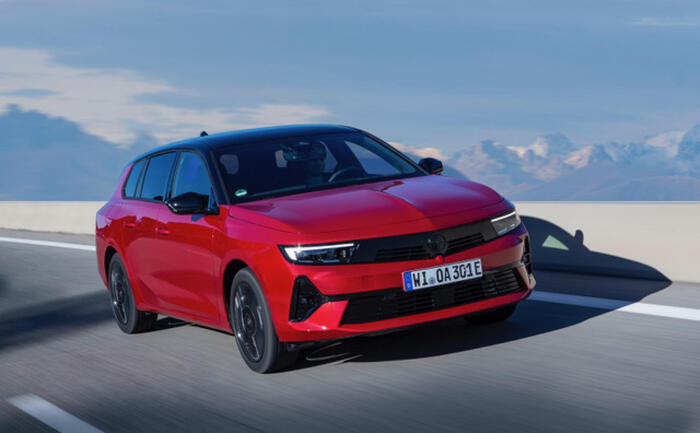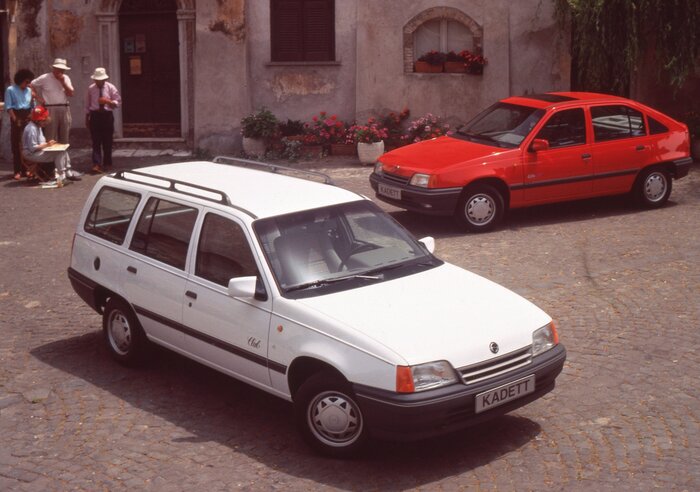Enlarge image
Photo:
Thorsten Weigl / Opel
A thing like the one with the Corsa shouldn't be repeated at Opel.
The engineers had almost finished developing the small car, when the takeover by the PSA group ruined the designs.
In a snap, the new generation had to be converted to the French platform.
After all, that's why the Corsa is also available as an electric car.
In Germany, more than 30 percent of customers take the small car with battery drive - as with the technically identical Mocha.
The timing of the Astra was more appropriate.
With him, Opel was able to collect the components from the PSA kit right from the start.
It is all the more incomprehensible that the manufacturer chose an architecture (internally called EMP2 Version 3) that is not designed for purely battery-electric drives, but rather for plug-in hybrid drives.
The company left unanswered the question of why Opel decided to do so.
In the next few years, Opel will not have a full electric model in the Golf class and will be a whole generation behind its main competitor VW.
"It is a major competitive disadvantage not being able to offer a pure electric vehicle in this segment," says Stefan Bratzel, Director at the Center of Automotive Management (CAM) in Bergisch Gladbach.
In addition to the Golf as a plug-in hybrid, VW also offers the fully electric ID.3 for compact cars.
Opel has long lived with the reputation of being "forever second" to its opponent from Wolfsburg.
Although the second place in some segments cannot be maintained, given the competition from German premium brands and Hyundai.
In the past, the Astra had just a quarter of the number of registrations for the Golf in Germany.
In this comparison, Opel could catch up.
At least the first impression that could be gained when driving an Astra prototype allows this conclusion.
Clear edges
The exterior alone makes you want more.
In the dress of the yellow-black camouflage film, the Astra looks a little clumsy.
But when Opel presented the exposed version in a locked room - the official unveiling is on July 13th - the car had a sporty profile with clear edges and good proportions.
He will stand out.
At 4.37 meters, it is about as long as its predecessor, but optically it is more solid on the wheels.
Because it has become 51 millimeters wider, the roof is 15 millimeters lower and the wheelbase is 13 millimeters longer.
The so-called Vizor grill, in which the headlights and grill represent a design element, is already known from the mocha.
The most striking feature on the flank is the rear roof pillar (C pillar).
It is reminiscent of the dorsal fin of a shark and leaves a gap towards the roof.
There is really something to be amazed at in the cockpit.
There, Opel is showing a digital world that many would not have believed the volume manufacturer would have believed.
The displays and displays appear puristic, clean and of high quality, as one would expect in an Audi.
Behind the steering wheel, a huge, thin display extends over the center of the dashboard.
On the very left edge, it even takes the ventilation flaps.
This is so far unique in the automotive industry.
A sun protection film is also making its debut behind the glass cover of the display, where it should act like a blind.
Opel's designers were able to omit the often ugly roof over the advertisements, which gives the whole thing even more high-tech character.
Practical for everyday use: below the screen there are switches and buttons for functions that the driver would like to activate with one click instead of using the menu navigation on the display.
Even the classic rotary control for the volume is still there - unlike the VW Golf.
Opel is covering up the lack of a pure electric drive with a lot of comfort and good ideas.
The developers also wanted the Astra to drive better than many of its competitors' cars.
"We also want to differentiate ourselves from the other models within the Stellantis Group," says Rainer Bachen, chief development engineer. "The aim is to bring our DNA into the Astra." Bachen means a good mix of sportiness and comfort.
To achieve this, the developers designed the body to be 14 percent stiffer than on the previous model.
This should allow the car to be controlled more precisely.
"Stability at high speeds, high safety reserves and as much peace and quiet as possible in the interior were also in the foreground when designing the Astra," explains Bachen.
Steering could use more resistance
The calm was particularly noticeable on the test tour.
The Astra drives as quietly as if it belonged to the luxury class.
The rolling noises from the wheel arches are also barely noticeable.
The chassis and brakes are already optimally coordinated.
Only the steering could use more resistance.
"We still have various adjusting screws here for the software coordination," says Bachen, "this will be solved by the start of series production."
That will be in autumn, the market launch is planned for the end of January.
Then there will be the Astra - presumably for around 23,000 euros - as an entry-level version with a 1.2-liter three-cylinder petrol engine and 110 and 130 hp.
The only built-in diesel engine has 1.5 liters, four cylinders and 130 hp.
All engines come from the PSA group.
We drove the plug-in hybrid, which combines a 1.6-liter four-cylinder gasoline engine with an electric motor.
Both together bring it to 180 hp, so you can move forward confidently.
The electric motor alone can contribute 110 hp and gives the Astra driver an insight into the world of electromobility - at least for 59 kilometers.
At least this was what the display showed when the battery was full.
The strategy at Stellantis is that the most powerful models are always plug-in hybrids.
Opel will submit another variant with this drive next year.
It has a system output of 225 hp.
And a 300 PS performance all-wheel drive version should also be safe for the Astra, similar to the Opel Grandland, which is already available with this package.
Michael Specht is a freelance author and was supported in his research by Opel. Reporting is independent of this.














